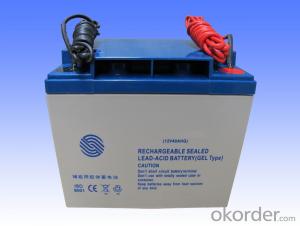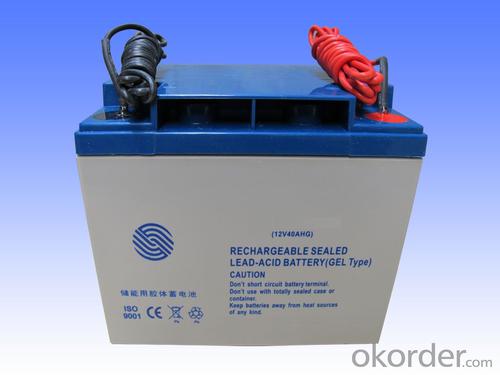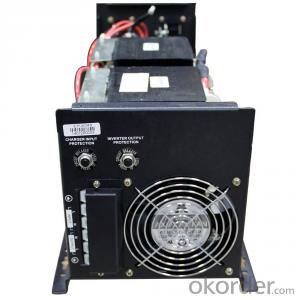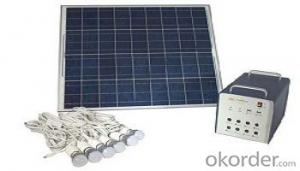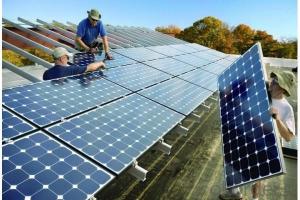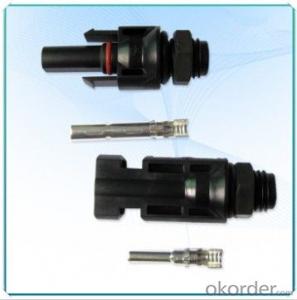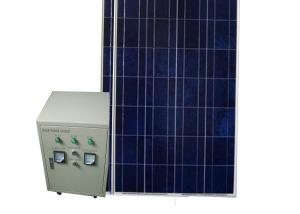Solar Energy Systems NSW Gel Storage Battery for Solar and Wind System
- Loading Port:
- China Main Port
- Payment Terms:
- TT or LC
- Min Order Qty:
- -
- Supply Capability:
- -
OKorder Service Pledge
OKorder Financial Service
You Might Also Like
What is the product?
· Precision explosion relief valve shall be adopted
· Advanced wrapping technology and assembly technology
· Designed life is fifteen years,excellent performance of battery in low temperature and superiority in consistence and stability
· Can be used at vertical or horizontal orientation
· Balanced design for both floating and cyclic operation
· Low self-discharge rate and long shelf life
· Connecting terminal adopts stainless steel bolt,thus it has the characteristics of high strength and non-deforming
· Design with patented corrosion resisting alloy and thickened plate
Gel Storage Battery (For Solar And Wind System) features:
1 Adopt suitable anode alloy formula, so that the battery is more suitable for the use of depth charge discharge cycle.
2 Colloidal electrolyte design, effectively inhibit AGM valve control lead-acid battery can not avoid electrolyte stratification phenomenon, and can better inhibit active substance loss and plate sulfation phenomenon, thus delaying the battery in the use of process performance decline, and improve the battery charge discharge cycle life.
3 Self discharge, Gel Storage Battery For Solar And Wind System has a longer service life, reduce the frequency and workload during storage battery maintenance.
4 Low floating charge voltage, charge current, battery charging efficiency is high; a good charge acceptance, less charge recovery ability.
Production facility, strict consistency of process requirements, to narrow the differences between individual battery; battery capacity, open circuit voltage and self discharge parameters matching, more consistent the battery pack in the individual characteristic curve, the overall performance is more excellent.
The battery electrolyte, - oxygen cycle is better than ordinary low water loss, prolong the service life of the battery.
5 Gel electrolyte way design and embedded copper core pole combined the battery safety further improved, the possibility of electrolyte leakage decreased further.
6 Gel Storage Battery For Solar And Wind System electrolyte using containing silica colloidal substances, is in gel state, does not flow; colloid injection for dilute sol state, good hydrophilicity, uniform dispersion, full of all the spaces inside the cell. Battery under high-temperature and overcharge conditions, resistant to over charging capability is strong, not easy to appear the phenomenon of dry, the gel battery has large heat capacity, heat dissipation is good, not easy to produce thermal runaway phenomenon. The battery can work in a more hostile environment.
It unique alloy and active material formulation, low-temperature discharge performance of battery greatly strengthened, and at the same time, the high performance of gelled electrolyte, the battery under the condition of low temperature charge acceptance ability improve, so as to ensure the battery excellent low-temperature discharge performance.
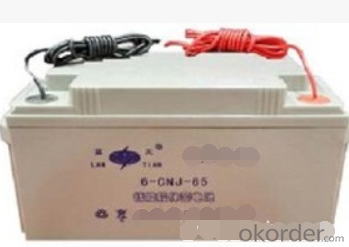
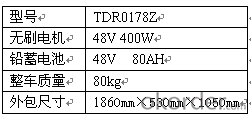
FAQ:
What's Application range?
*solar and wind power generation system
* communication systems: switches, microwave stations, mobile base stations, data centers, radio and radio station.
* the power plant and power transmission system;* signal system and emergency lighting system
What's the special advantage comparing with normal storage battery?
*The storage battery, with green environmental protection, long service life, self discharge, low internal resistance, good safety performance, characteristics of a wide range of temperature and so on, once for Xinjiang, Tibet, Qinghai and other light engineering support, Armed Police Frontier Corps provides large amount of photovoltaic system and power supply facilities, the existing product sales throughout the country, some products are also exported to Europe and the United States, to its quality and cheap access to the users.
How do you pack your products?
*We have rich experience on how to pack the panels to make sure the safety on shipment when it arrives at the destination.
- Q: How do solar energy systems affect job growth in the renewable energy sector?
- Solar energy systems have a positive impact on job growth in the renewable energy sector. The installation, maintenance, and manufacturing of solar panels create a significant number of employment opportunities. Additionally, as the demand for solar energy increases, more jobs are created in research, development, and innovation of solar technologies. Overall, solar energy systems contribute to job growth by providing employment opportunities in various sectors of the renewable energy industry.
- Q: Can solar panels be installed on different types of roofs?
- Yes, solar panels can be installed on different types of roofs including flat, sloped, shingled, metal, and tile roofs. The installation process may vary depending on the roof type, but with proper mounting systems and professional installation, solar panels can be successfully installed on various roof types.
- Q: Can solar energy systems be used in powering hotels or resorts?
- Yes, solar energy systems can be used to power hotels or resorts. Solar panels can be installed on the rooftops or open spaces of these buildings to harness sunlight and convert it into electricity. This renewable source of energy can provide a significant portion or even the entire power required for the hotel or resort, reducing reliance on traditional fossil fuel-based electricity and lowering operational costs. Additionally, solar energy systems can also be integrated with other energy-efficient technologies like energy storage systems and smart grids to ensure uninterrupted power supply and optimize energy usage.
- Q: Can a solar energy system be installed in a coastal area?
- A solar energy system can indeed be installed in a coastal area, and in fact, coastal areas offer ideal conditions for solar installations due to their ample sunlight and close proximity to the ocean. However, there are certain factors to consider when installing a solar energy system in such areas. Firstly, one must take into account the corrosive nature of the salty air found in coastal regions. Salt can accelerate the deterioration of various components of a solar system, including metal frames, electrical connections, and even the solar panels themselves. To counteract this, it is crucial to use materials that are resistant to corrosion and to regularly clean and maintain the system to prevent any salt buildup. Another consideration is the potential impact of strong winds and storms that are common in coastal areas. Solar panels and mounting structures must be designed and installed in a way that can withstand these extreme weather conditions. Reinforced anchoring and proper installation techniques can help guarantee the stability and durability of the system in areas with high wind speeds. Additionally, it is important to evaluate the potential effects of coastal erosion or flooding on the chosen location for the solar energy system. By carefully selecting the site and elevating it appropriately, the risk of damage from these environmental factors can be minimized. Despite these challenges, it is possible to successfully install and operate a solar energy system in a coastal area with proper planning, design, and maintenance. The advantages of harnessing the abundant sunlight in these regions outweigh the potential difficulties, making solar energy a viable and sustainable choice for coastal communities.
- Q: Can solar energy systems be used for water heating in swimming pools?
- Yes, solar energy systems can be used for water heating in swimming pools. Solar panels can be installed to capture the sun's energy and heat the water in the pool, providing an eco-friendly and cost-effective solution for pool heating.
- Q: Can solar energy systems be installed in areas with heavy snowfall?
- Yes, solar energy systems can be installed in areas with heavy snowfall. However, it is important to consider the impact of snow on the system's performance and take necessary precautions during installation. Snow can temporarily reduce the amount of sunlight reaching the solar panels, which in turn reduces their energy production. However, the panels are designed to have a tilt and smooth surface, allowing snow to slide off easily. Additionally, advancements in technology have led to the development of snow-resistant solar panels that are more effective at converting sunlight into electricity even in snowy conditions. It is also worth noting that solar panels are often mounted at an angle to maximize their exposure to the sun, which helps to minimize snow accumulation. Overall, while heavy snowfall may impact the efficiency of solar energy systems, they can still be successfully installed and can contribute to renewable energy generation in areas with such climatic conditions.
- Q: What is the role of solar energy systems in reducing dependence on fossil fuels?
- Solar energy systems play a crucial role in reducing dependence on fossil fuels by providing a clean and renewable source of energy. Fossil fuels, such as coal, oil, and natural gas, have been the primary sources of energy for centuries. However, their extraction, transportation, and combustion have significant environmental impacts, including air pollution, greenhouse gas emissions, and climate change. Solar energy systems, on the other hand, utilize the power of the sun to generate electricity. Solar panels, made up of photovoltaic cells, convert sunlight into usable energy without emitting any harmful pollutants. This clean energy source not only helps to mitigate climate change but also improves air quality and reduces health risks associated with fossil fuel combustion. By embracing solar energy systems, we can reduce our dependence on fossil fuels for electricity generation, heating, and cooling. Solar power is abundant, widely distributed, and available throughout the year, making it a reliable and sustainable energy option. Moreover, solar energy systems can be installed on various scales, from residential rooftops to large-scale solar farms, allowing individuals, communities, and businesses to contribute to the transition away from fossil fuels. Not only does solar energy reduce our carbon footprint, but it also provides economic benefits. As the technology advances and becomes more widespread, the cost of solar panels and installation continues to decline. This makes solar energy more affordable and accessible for both individuals and businesses, leading to job creation and economic growth in the renewable energy sector. Furthermore, solar energy systems offer energy independence and resilience. Unlike fossil fuels, which are finite resources and subject to price volatility, sunlight is abundant and freely available. By harnessing solar power, we can reduce our reliance on imported fossil fuels, enhance energy security, and create a more stable and sustainable energy supply. In conclusion, solar energy systems play a crucial role in reducing dependence on fossil fuels. By harnessing the power of the sun, we can transition to a cleaner, more sustainable, and resilient energy future. Solar energy helps mitigate climate change, improve air quality, create jobs, and provide energy independence. It is a viable solution that enables us to reduce our environmental footprint while meeting our energy needs.
- Q: Can solar energy systems be used in powering car charging stations?
- Yes, solar energy systems can definitely be used to power car charging stations. In fact, many car charging stations around the world are already powered by solar energy. Solar panels can be installed on the roof or nearby the charging station, which then captures sunlight and converts it into electricity. This renewable energy can be used to charge electric vehicles (EVs) without relying on the traditional power grid. Solar-powered car charging stations offer several advantages. Firstly, they provide a sustainable and clean source of energy, reducing carbon emissions and the overall environmental impact of EVs. Secondly, they can be installed in remote or off-grid locations where it may be challenging or expensive to connect to the electrical grid. This makes solar-powered charging stations particularly beneficial for rural areas or highways that lack easy access to electricity. Furthermore, solar energy systems can be designed to include battery storage, allowing the excess energy generated during the day to be stored and used during the night or during times of high demand. This ensures a continuous and reliable source of power for car charging stations, even when sunlight is not available. Although the initial installation cost of solar energy systems may be higher compared to traditional power sources, they generally have lower operating and maintenance costs in the long run. Additionally, there are various government incentives and rebates available to promote the use of renewable energy, which can help offset these initial costs. Overall, solar energy systems are a viable and sustainable solution for powering car charging stations, offering environmental benefits, energy independence, and cost savings in the long term.
- Q: Can solar energy systems be used for powering off-grid construction sites?
- Yes, solar energy systems can be used to power off-grid construction sites. These systems can provide a reliable and sustainable source of electricity for various construction activities, including powering tools, equipment, lighting, and temporary facilities. Solar panels can be installed on-site to harness sunlight and convert it into electricity, which can then be stored in batteries for use during non-sunlight hours. This allows construction sites to operate efficiently and reduce their reliance on traditional fuel-powered generators, leading to cost savings and environmental benefits.
- Q: Are there any financial incentives for installing solar energy systems?
- Yes, there are several financial incentives for installing solar energy systems. These incentives vary by location, but some common examples include federal tax credits, state and local rebates, performance-based incentives, and net metering. These incentives can significantly reduce the upfront cost of installing solar panels and can provide ongoing financial benefits through energy savings and potential income from excess energy production.
Send your message to us
Solar Energy Systems NSW Gel Storage Battery for Solar and Wind System
- Loading Port:
- China Main Port
- Payment Terms:
- TT or LC
- Min Order Qty:
- -
- Supply Capability:
- -
OKorder Service Pledge
OKorder Financial Service
Similar products
Hot products
Hot Searches
Related keywords
